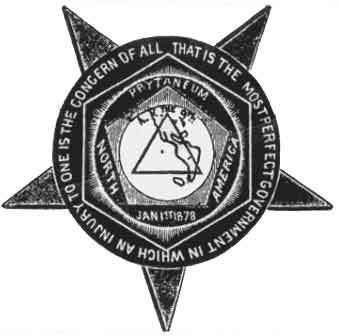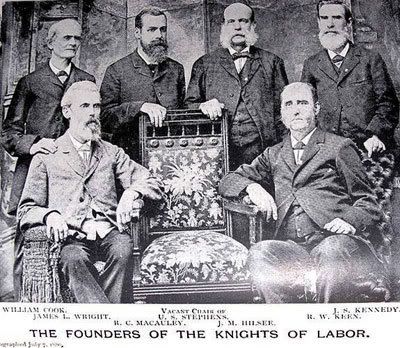The reason Labor Day exists is because of a long-defunct labor union known as the Noble and Holy Order of the Knights of Labor. This labor union didn't allow bankers to join. It also excluded doctors, lawyers, gamblers, stockholders, and liquor manufacturers because they were considered "unproductive members of society".
Considering the insane amounts of money that investment bankers get paid to move other people's money around, the Knights of Labor may have had a point.

Don't think that the Knights were exclusive. They were by far the most inclusive labor union up to that point in American history, and that was the reason for their demise.
But I'm getting ahead of myself.
Radical ideas

The Knights of Labor was founded in Philadelphia in 1869 by Uriah H. Stevens and and six other tailors.
It was initially structured along the lines of a secret society in order to protect its members from company thugs. The Knights demanded an end to child and convict labor, an eight-hour workday, equal pay for women, a progressive income tax, better wages, and the cooperative employer-employee ownership of mines, factories.
The most far-reaching idea of the Knights was the idea of a union that encompassed all forms of labor, both skilled and unskilled. Since the beginning of the industrial revolution, the only successful unions had been trade unions of skilled workers.
Only one other union, the short-lived National Labor Union dared to think otherwise. For a while the NLU grew and was on the verge of being a powerful voice for labor in America, even to the point of getting an eight-hour workday for federal workers in 1868. But then the leadership made a fateful decision - it adopted the policy that electoral politics was the only means for advancing its agenda. The 1872 election was disastrous and the membership soon fled.
The Panic of 1873 compounded labor's problems. Most labor unions didn't survive the economic depression that quickly encompassed the nation. The Knights were the exception.
The Knights largely followed the NLU's platform, although with several important exceptions.
Like the NLU, the Knights supported the exclusion of Chinese workers from the American workforce. The Knights initially excluded blacks from the union, like the NLU, but changed that policy in 1883 (although they continued to overlook discrimination against blacks).
Like the NLU, the Knights supported arbitration over strikes, although they became more confrontational before the end.
But the big difference between the NLU and the Knights was the inclusion of women. The NLU only gave lip-service to women's rights on the job and did no active recruitment of women. The Knights began with much the same agenda, but that quickly changed until women were an important part of the union. By 1886, the Knights had 50,000 black members and 50,000 women members.
One female member worth noting is my favorite American woman in history, Mary Harris Jones.

"I'm not a humanitarian. I'm a hell-raiser."
- Mother Jones
Mary Jones came from a long line of agitators. Born in Ireland, she had watched British soldiers march through the streets of Cork, the heads of Irishmen stuck on their bayonets. Her grandfather was a freedom fighter and was hanged for it, a condition that forced her family to flee to America while she was still young.
Tragedy struck her life in 1867 when a yellow fever epidemic took the lives of her husband and four small children. A few years later all her worldly possessions were lost in the Great Chicago Fire of 1871. It was at this point in her life that she encountered the Knights.
Mother Jones's low, pleasant voice had great carrying power. It was unusual because it "did not become shrill when she became excited but, rather, dropped in pitch so that 'the intensity of it became something you could almost feel physically.' When she rose to speak, Mother Jones 'seemed to explode in all directions' . . . and suddenly everyone sat up alert and listened. No matter what impossible ideas she brought up, she made the miners think she and they together could do anything."
Elizabeth Gurley Flynn, a nationally known labor organizer, called Jones "the greatest woman agitator of our times." She was denounced in the U.S. Senate as the grandmother of all agitators. Mother Jones was proud of that title and said she hoped to live to be the great grandmother of agitators.
One biographer believes that Mother Jones's interest in the labor movement really began when she sewed for wealthy Chicago families and observed the blatant economic and social inequities that existed. According to Fetherling, she said: "Often while sewing for the lords and barons who lived in magnificent houses on the Lake Shore Drive, I would look out of the plate glass windows and see the poor, shivering wretches, jobless and hungry, walking alongside the frozen lake front.... The contrast of their condition with that of the tropical comfort of the people for whom I sewed was painful to me. My employers seemed neither to notice nor to care."
"There sits the most dangerous woman in America. She crooks her finger—twenty thousand contented men lay down."
- West Virginia District Attorney named Reese Blizzard, 1902
Jones' involvement with labor unions would outlive the Knights.
Rise to Power
The transition of the Knights from a secret organization to a major labor union started with the election of Terence Powderly in 1879.
Powderly managed to convince the General Assembly to make its name and objects public in 1881, and the Knights grew quickly after this. By 1886 membership had reached over a million.

Terence Powderly
Although the Knights never favored striking, the improving economy of the 1880's and the increased resources of the growing union, they found themselves leading several large strikes in the middle of the decade.
In 1884 the Knights won a strike against Jay Gould's Union Pacific Railroad. In 1885 2,500 women walked out of New York carpet mill after some leaders were fired for joining a union. When police arrested three of the strikers for "walking on the street," thousands of local union members rallied to their cause.
Labor Day
The first Labor Day celebration was held on September 5, 1882, and was organized by the Knights of Labor. The Knights began holding it every year and called for it to be a national holiday, but this was opposed by other labor unions who wanted it held on May Day (like it is everywhere else in the world).
After the Haymarket Square riot in May, 1886, President Cleveland feared that commemorating Labor Day on May 1 could become an opportunity to commemorate the riots. Thus he moved in 1887 to support the Labor Day that the Knights supported.
Decline and Fall
The collapse of the Knights can be attributed to three different causes, all happening in the year 1886.
#1) The Haymarket Square Riot. This has been covered in numerous other diaries so I won't go into too many details.
The general strike for a national eight-hour workday was actually opposed by the Knights of Labor. However, the fallout fell heavily on the Knights as organized violence targeted labor leaders.
#2) The Great Southwest Railroad Strike.
The strike started when several employees of Union Pacific were fired for attending a union meeting on company time. The Knights called a strike and soon 200,000 members from Illinois to Texas were out on strike. Although the firing was the trigger for the strike, hours, wages, and unsafe working conditions were the real reason for the strike.
But Jay Gould had no plans of giving in this time.
Gould immediately hired strikebreakers to work the railroad, allegedly declaring, "I can hire one half of the working class to kill the other half."
Pinkerton detectives were employed to break up union meetings, beat union leaders and sympathizers, and commit acts of violence that were to be blamed on the Knights.
The "union violence" was an excuse for Gould to call for federal troops to break up the strike. Texas mobilized both the militia and the Texas Rangers.
Eventually the strikers responded to the violence against them with their own violence, and public sympathy turned against them. By late 1886 the strike had been crushed.
#3) The single greatest reason for the decline of the Knights of Labor was the formation of the American Federation of Labor.
Unlike the Knights, the AFL didn't organize unskilled workers, didn't participate in politics, and favored autonomy for the individual trade unions. Skilled workers began abandoning the Knights in droves.
As the Knights went into decline, various factions began to bicker and compete. By 1890 membership had declined to 100,000. In 1893 Powderly was replaced by James Sovereign.
In 1895 members of the Socialist Labor Party left the Knights to form their own union. With leftists in their own union, and more conservative members having joined the AFL, the Knights limped slowly towards oblivion. When the IWW was formed in 1905 the Knights failed to have a reason to exist and no longer existed as a true labor union.

Comments
I love this labor organization series
But where are we today? Seems we have organized unions who frankly aren't making enough inroads to groups that really need representation...Professionals.
Movie suggestion
I know it's early, but I won't get a chance this Saturday. How about the movie Reds? No, not because the Communist element, but early in the movie and throughout the rest, the main character is promoting the IWW. It's mentioned in this wonderful diary post. Thought it was relevant.
--------------------------------------------
www.venomopolis.com
IWW/Wobblies Friday Night Video
IWW, Wobblies documentary.
Reds is a little hollywood, a biography, more focused in on personal relationships, & I'm not sure how historically accurate it is, but more importantly, can I find it online, embeddable and not a copyright violation in doing so?
That's a key element to the Friday Night videos. ;)